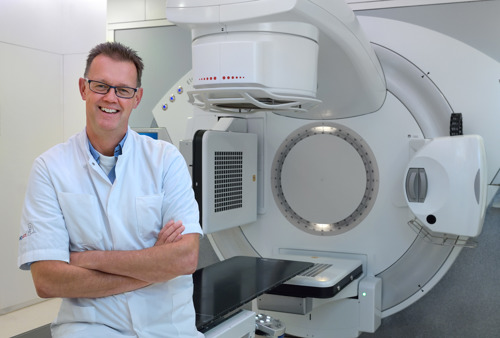Inaugural lecture: 'Off the beaten track for better individual radiotherapy
2 Sep 2021 09:00
About fifty different types of sarcoma are known, and all of them are treated with the same dose of radiotherapy. According to Rick Haas, Professor of Radiotherapy at the Netherlands Cancer Institute and LUMC, in particular of bone and soft tissue tumors, this should be improved. In his inaugural lecture, 'Dosed deviations and deviating doses', which he will deliver on 3 September, Haas will emphasize the importance of research into adapting the standard dose of radiation for sarcoma patients.

Radiation oncologist Rick Haas has dedicated his entire scientific career to new ways to optimize tumor radiotherapy. This means that the radiation can kill tumor cells while simultaneously causing as little damage to the body as possible. "During my training, I was already astonished by the fact that a patient with a soft tissue tumor, also known as sarcoma, receives 25 radiation sessions, regardless of the characteristics of the patient or tumor. It just didn’t feel right to me."
Less radiation, more effect
This astonishment became the basis for a study into a lower radiation dose for patients with a certain sarcoma subtype called myxoid liposarcoma. In this study, patients received 18 radiation sessions instead of 25. “It was a huge success,” Haas proclaims. "We had complete control over the sarcomas, and the short and long-term side effects were reduced by half." This gave Haas even more reasons to investigate different doses for other sarcoma types.
Impact on the quality of life
Reducing or preventing side effects is an important outcome measure of Haas' research. These can be quite a strain on our patients, he states. "In the long term, radiotherapy can lead to scarring and stiff joints. Because sarcomas frequently occur in the arms and legs, this can have a huge impact on the patients' quality of life. We also see that the surgical incision after tumor removal heals more slowly after 25 sessions of radiotherapy. But the good news is that this effect is eliminated once we reduce the number of sessions from 25 to 18."
Promising results
In addition to the effect of lower doses, Haas also wants to look at the combination of radiation and chemotherapy over the coming years. "This requires a multidisciplinary approach," says Haas, who works as a radiation oncologist at the Antoni van Leeuwenhoek and LUMC. "I actually function as a bridge between the two hospitals so that we can initiate these kinds of studies together." The rare nature of sarcomas underlines the importance of these collaborations. "Approximately 800 people are diagnosed with sarcomas every year," Haas explains. "In order to recruit enough patients for research, we have to work together."
Dare to deviate
Many medical specialists are involved in the treatment of sarcomas. "A collaboration between surgeons, radiotherapists, internists, pathologists, and radiologists is essential in sarcoma treatment. Especially the expertise of these last two groups is indispensable for our research. I greatly appreciate this collaboration and their input – I couldn’t do this without them."
The results of Haas' research may be promising, but the 25 radiation sessions are still the standard treatment for all sarcoma types. "I am confident that we can obtain sufficient scientific evidence to tweak not only the total dose but also the radiation dose per day. We hope that this will permanently change the future guidelines, and improve sarcoma care."
Read more:
- About his appointment
- Haas’ recent findings about safely reducing radiotherapy sessions for myxoid liposarcoma
 nl
nl
 Nederlands
Nederlands